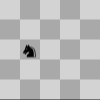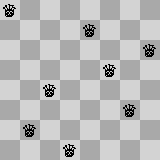Onwards and upwards! For today’s chess puzzle, let’s take a first crack at the Knight’s Tour1

Onwards and upwards! For today’s chess puzzle, let’s take a first crack at the Knight’s Tour1

After two weeks, it seems only right that we actually get around to a real chess puzzle. First on the list: Eight queens puzzle.

Specifically, how do you place n queens on an n by n chess board such that no pair of queens can attack one another?
Now that we’ve got Ludum Dare out of the way, back to chess! Last time, we defined all of the pieces, which is all well and good, but what we really need is a board. More specifically, we want something that can:
I think that’s about enough for the moment. Let’s do it!
Here’s something I haven’t done much1: chess puzzles! I’m still not sure entirely what I think about the game in general. There is certainly quite a lot of strategy, which I like, but to really get good at chess, there’s also some amount of memorizing openings and closings. That’s something I’m a little less thrilled with.
Still, it’s the perfect sort of came to work out programming exercises with. It’s a game of perfect information, so you don’t have to deal with what a player knows and doesn’t. The pieces have well defined, regular moves2 There’s a fairly intense branching factor, but not insurmountable–Deep Blue (chess computer) proved that.
Anyways, enough chatter. Let’s play some chess!